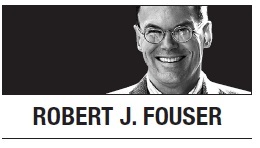[Robert Fouser] Looking forward from the 2017 election
By Korea HeraldPublished : May 23, 2017 - 17:42
 President Moon Jae-in took office on May 10, the day after he won a sweeping election victory.
President Moon Jae-in took office on May 10, the day after he won a sweeping election victory. Each day since he took office has brought refreshing surprises that have earned him high marks. His election brings a third swing in the 10-year cycle of Korean politics. Each swing has been marked by high hopes and good will.
Moon has begun moving on his promised economic, political and social reforms, many of which will face resistance in the National Assembly.
However, the lack of a transition period for the new president has left little time to analyze the May 9 election. Except for a few days at the beginning of the campaign period, Moon had a solid lead in the polls and was the favorite to win.
Predictable elections are always less interesting then close elections or sudden upsets. A look at the results, however, reveals interesting trends that will affect the new president’s prospects.
Maps of Korea after the election showed most of the country colored blue (the Democratic Party’s campaign color).
Only Daegu and the surrounding North Gyeongsang Province and South Gyeongsang Province gave a plurality of their votes to the conservative Liberty Korea Party candidate Hong Joon-pyo. Moon swept the nation, but won only 41 percent of votes to Hong’s 24 percent. The People’s Party’s candidate Ahn Cheol-soo had come close to Moon at the beginning of the campaign period, but fell far short, winning only 21 percent of votes. Therefore, Moon became president with 41 percent of votes, the lowest winning percentage since Kim Dae-jung received 40 percent in 1997.
Winning only 41 percent of votes means that 59 percent of the nation voted for someone else. In addition to Hong and Ahn, center-right Bareun Party candidate Yoo Seung-min received nearly 7 percent of the votes, while left-leaning Justice Party candidate Sim Sang-jeung received 6 percent.
Yoo had hoped to capitalize on Hong’s weaknesses as a candidate to become the new conservative voice, but his candidacy failed to catch fire. Sim, on the other hand, did well in televised debates and ended up becoming the first strongly progressive candidate to win more than 5 percent of votes in Korean history.
Classifying political parties in Korea by ideology is difficult because they have traditionally relied on regional support. A rough classification, however, would put President Moon and Sim to the left of the center, and Hong and Yoo to the right of the center. Ahn Cheol-soo straddles, meanwhile, both sides of the center.
The total votes for left-of-center candidates Moon and Sim was 47 percent, which is only a little lower than the 48 percent percent that Moon received when he lost to Park Geun-hye in 2012. The total votes of right-of-center candidates Hong and Yoo was 31 percent, the lowest level of support for conservatives in history. The gap between the center left and center right is also the largest in history. Voters clearly blamed the center-right parties for the Park Geun-hye debacle and punished them at the polls.
One important question is where Ahn’s supporters will go from here. Ahn broke away from the Democratic Party and many of his supporters lean in that direction. Others supported him as an alternative to Moon, but many of those people moved toward Hong as Ahn fell in the polls. Others supported him because they liked his centrist positions.
If a third of Ahn’s voters are sympathetic toward President Moon, this would account for 7 percent of the vote. When added to the center-left, that brings the total to 54 percent, which is a clear majority. To keep his popularity above 50 percent, President Moon needs to reach out to Ahn’s voters. The Democratic Party currently has only 120 seats of the 300-member National Assembly. He will need support from Ahn’s People’s Party to pass bills. Reaching out to Ahn’s voters will also strengthen the Democratic Party’s prospects in the 2020 National Assembly election.
The election showed that regionalism, though weakened, remains a potent factor in elections. Hong, who opposed Park’s impeachment, garnered strong support in her home base of Daegu and surrounding areas. Moon, meanwhile, did best in the Jeolla region, the traditional regional base of the Democratic Party.
With only about a third of the voters strongly against him, President Moon is in a strong position to build a ruling coalition. To do so, he will need to reach out to the center, even at the risk of criticism from the left. How President Moon deals with this tension after his honeymoon period ends will determine the future of his presidency.
By Robert J. Fouser
Robert J. Fouser, a former associate professor of Korean language education at Seoul National University, writes on Korea from Pawtucket, Rhode Island. He can be reached at robertjfouser@gmail.com. -- Ed.
-
Articles by Korea Herald







![[Graphic News] More Koreans say they plan long-distance trips this year](http://res.heraldm.com/phpwas/restmb_idxmake.php?idx=644&simg=/content/image/2024/04/17/20240417050828_0.gif&u=)
![[KH Explains] Hyundai's full hybrid edge to pay off amid slow transition to pure EVs](http://res.heraldm.com/phpwas/restmb_idxmake.php?idx=644&simg=/content/image/2024/04/18/20240418050645_0.jpg&u=20240419100350)






![[From the Scene] Monks, Buddhists hail return of remains of Buddhas](http://res.heraldm.com/phpwas/restmb_idxmake.php?idx=652&simg=/content/image/2024/04/19/20240419050617_0.jpg&u=20240419175937)

![[KH Explains] Hyundai's full hybrid edge to pay off amid slow transition to pure EVs](http://res.heraldm.com/phpwas/restmb_idxmake.php?idx=652&simg=/content/image/2024/04/18/20240418050645_0.jpg&u=20240419100350)

![[Today’s K-pop] Illit drops debut single remix](http://res.heraldm.com/phpwas/restmb_idxmake.php?idx=642&simg=/content/image/2024/04/19/20240419050612_0.jpg&u=)